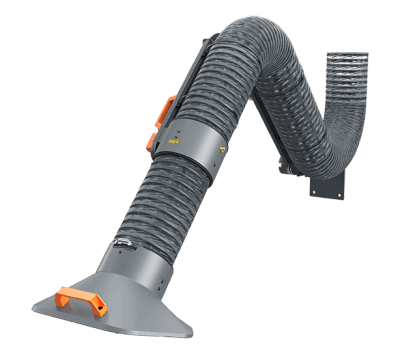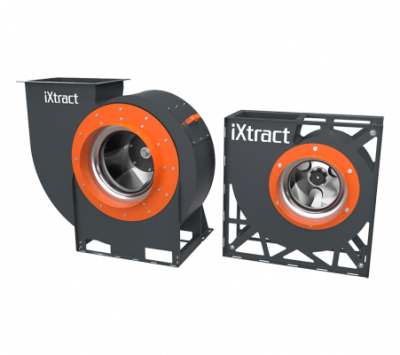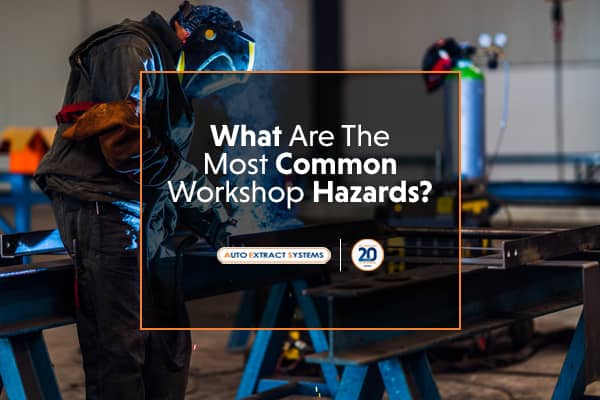Workshops can be dangerous places where harmful dust, fumes and vapours are produced during welding, painting and woodworking. These contaminants can pose a significant risk to the health and safety of workers if not adequately controlled.
As a company specialising in Local Exhaust Ventilation (LEV) systems, we understand the importance of protecting workers from exposure to hazardous substances. This article will provide insight into the common hazards found in workshops and how LEV systems can effectively control them. By implementing effective LEV solutions, you can ensure workers stay safe and healthy while focusing on their craft.
Hazards you can face in a workshop
Creativity and artisanship come together in workshops. However, amid all the tools and machinery, there are hidden dangers that can threaten your safety and well-being.
Dangerous equipment or areas without guards or screens
One of the most common workshop hazards is the absence of guards or screens around dangerous equipment. Guards and screens are designed to prevent workers from coming into contact with moving parts, sparks, flying debris or other risks that can cause cuts, burns, amputations or eye injuries. Damaged or misused safety equipment can also pose a threat to employees.
To avoid it, the staff should always check that equipment has adequate safety measures before using it and report any defects or damage to their supervisor. Employees should also follow the manufacturer’s instructions on using and maintaining equipment safely and never remove or bypass guards or screens. An example of potentially dangerous machinery is a conveyor system, which workshops may use to move materials efficiently. Adequate conveyor maintenance is essential to ensure the system runs correctly and safely.
Absence of safety signs
Safety signs warn workers about potential dangers such as electric shocks, fire risks, slippery floors or the presence of sharp objects. They can also teach workers what to do in an emergency, such as calling for help, using fire extinguishers or evacuating the premises.
That’s why workshops should have clear, up-to-date, visible safety signs that comply with relevant standards and regulations. Employees should also familiarise themselves with the meaning of different safety signs and follow their directions.
Misplaced items and pieces of equipment
A clutter is a collection of things lying around in an untidy mess. In a bedroom or office, clutter might be just an inconvenience. However, it can pose severe hazards to workers and equipment in workshops. Clutter can create tripping, slipping and falling risks, as well as fire hazards from flammable materials or electrical cords. It can also obstruct access to emergency exits, fire extinguishers and first aid kits. Furthermore, untidiness can reduce the efficiency and productivity of workers by making it harder to find tools and materials.
Maintaining a clean and organised workshop environment is crucial to ensuring the safety of everyone who works there. You can help create a safe and efficient workspace by following some simple steps. This includes designating specific areas for tools and equipment when they are not in use, as well as properly disposing of waste materials regularly.
Additionally, labelling containers and shelves, keeping aisles and walkways clear of obstructions, and reporting any spills or leaks as soon as they happen are necessary practices.
Lack of proper ventilation and temperature
Another common problem is the absence of adequate ventilation and temperature control. Workshops can generate dust, fumes, vapours, gases or smoke from various processes such as welding, cutting, grinding, painting or cleaning. These substances can affect workers’ health by causing respiratory problems, skin irritation, headaches, nausea, drowsiness or even poisoning.
Workshops must always have sound ventilation systems to remove contaminated air. Workers should also wear appropriate personal protective equipment (PPE) such as respirators, gloves, goggles or aprons when handling unsafe substances. They should also monitor temperature and humidity levels and take breaks in cooler areas if needed.
Preventing Exposure to Dust and Fumes
Exposure to dust and fumes is one of the most severe hazards posed by workshops. Dust and fumes can come from various sources, such as wood, metal, plastic or paint. Some specks of dust and fumes can also lead to allergic reactions, asthma attacks, cancer or chronic diseases.
In order to prevent exposure to these harmful substances, workshops need an adequate dust extraction solution that captures airborne particles at its source before it spreads into the air. The most effective solution is often installing an LEV (local exhaust ventilation) system. It generally consists of a hood, a ducting system, a fan and a filter.
An LEV system draws dust away from workers’ breathing zones, transports it through ducts and filters it before releasing it outside.
Auto Extract Systems Ltd, a leading provider of workshop dust extraction solutions in the UK, offers a range of LEV systems for different types of workshops, such as woodworking, metalworking or vehicle repair. It also provides installation, maintenance and testing services for its products.
Don’t let dust and fumes compromise your health and safety. Contact Auto Extract Systems Ltd today for a free site assessment and to see how we can help you with dust and fume extraction.







































